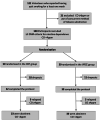Virtual reality cue exposure therapy for tobacco relapse prevention: a comparative study with standard intervention
- PMID: 35924727
- PMCID: PMC10476066
- DOI: 10.1017/S0033291722002070
Virtual reality cue exposure therapy for tobacco relapse prevention: a comparative study with standard intervention
Abstract
Background: Successful interventions have been developed for smoking cessation although the success of smoking relapse prevention protocols has been limited. Cognitive behavioural therapy (CBT) in particular has been hampered by a high relapse rate. Because relapse can be due to conditions associated with tobacco consumption (such as drinking in bars with friends), virtual reality cue exposure therapy (VRCE) can be a potential tool to generate 3D interactive environments that simulate risk situations for relapse prevention procedures.
Methods: To assess the effectiveness of VRCE with CBT, a comparative trial involving 100 smoking abstinent participants was designed with all required virtual environments (VE) created with an inexpensive graphic engine/game level editor.
Results: Outcome measures confirmed the immersive and craving eliciting effect of these VEs. Results demonstrated that more participants in the VRCE group did not experience smoking relapse and that VRCE is at least as efficacious as traditional CBT in terms of craving reduction and decrease in nicotine dependence. Dropout and relapse rate in the VRCE group was noticeably lower than the CBT group. Aside from mood scores, no significant differences were found regarding the other scales.
Conclusion: The present clinical trial provides evidence that VRCE was effective in preventing smoking relapse. Improvement in technology and methodology for future research and applications is delineated.
Keywords: Cue exposure therapy; game level editor; tobacco relapse prevention; virtual environments; virtual reality.
Figures





Similar articles
-
Virtual reality cue exposure as an add-on to smoking cessation group therapy: a randomized controlled trial.Addict Sci Clin Pract. 2025 Apr 11;20(1):34. doi: 10.1186/s13722-025-00561-2. Addict Sci Clin Pract. 2025. PMID: 40211338 Free PMC article. Clinical Trial.
-
Virtual reality cue exposure for the relapse prevention of tobacco consumption: a study protocol for a randomized controlled trial.Trials. 2016 Feb 19;17:96. doi: 10.1186/s13063-016-1224-5. Trials. 2016. PMID: 26892001 Free PMC article. Clinical Trial.
-
Mindfulness-based relapse prevention combined with virtual reality cue exposure for methamphetamine use disorder: Study protocol for a randomized controlled trial.Contemp Clin Trials. 2018 Jul;70:99-105. doi: 10.1016/j.cct.2018.04.006. Epub 2018 Apr 19. Contemp Clin Trials. 2018. PMID: 29679670 Clinical Trial.
-
The Use of Virtual Reality in the Production of Cue-Specific Craving for Cigarettes: A Meta-Analysis.Nicotine Tob Res. 2016 May;18(5):538-46. doi: 10.1093/ntr/ntv216. Epub 2015 Oct 8. Nicotine Tob Res. 2016. PMID: 26453669
-
Applications of virtual reality in individuals with alcohol misuse: A systematic review.Addict Behav. 2018 Jun;81:1-11. doi: 10.1016/j.addbeh.2018.01.036. Epub 2018 Feb 2. Addict Behav. 2018. PMID: 29421343
Cited by
-
Isradipine augmentation of virtual reality cue exposure therapy for tobacco craving: a triple-blind randomized controlled trial.Neuropsychopharmacology. 2024 Oct;49(11):1711-1718. doi: 10.1038/s41386-024-01872-9. Epub 2024 May 24. Neuropsychopharmacology. 2024. PMID: 38789642 Clinical Trial.
-
Cue-reactivity targeted smoking cessation intervention in individuals with tobacco use disorder: a scoping review.Front Psychiatry. 2023 Sep 7;14:1167283. doi: 10.3389/fpsyt.2023.1167283. eCollection 2023. Front Psychiatry. 2023. PMID: 37743997 Free PMC article.
-
Virtual reality cue exposure as an add-on to smoking cessation group therapy: a randomized controlled trial.Addict Sci Clin Pract. 2025 Apr 11;20(1):34. doi: 10.1186/s13722-025-00561-2. Addict Sci Clin Pract. 2025. PMID: 40211338 Free PMC article. Clinical Trial.
-
The efficacy of conventional and technology assisted cue exposure therapy for treating substance use disorders: a qualitative systematic review.Front Psychiatry. 2025 Mar 26;16:1544763. doi: 10.3389/fpsyt.2025.1544763. eCollection 2025. Front Psychiatry. 2025. PMID: 40206652 Free PMC article.
-
A superior colliculus-originating circuit prevents cocaine reinstatement via VR-based eye movement desensitization treatment.Natl Sci Rev. 2024 Dec 26;12(4):nwae467. doi: 10.1093/nsr/nwae467. eCollection 2025 Apr. Natl Sci Rev. 2024. PMID: 40160681 Free PMC article.
References
-
- American Psychiatric Association (2013). Diagnostic and statistical manual of mental disorders (5th ed.). Washington, DC: American Psychiatric Association.
-
- Bagot, K., Heishman, S., & Moolchan, E. (2007). Tobacco craving predicts lapse to smoking among adolescent smokers in cessation treatment. Nicotine & Tobacco Research, 9(6), 647–652. - PubMed
-
- Baumann, S., & Sayette, M. (2006). Smoking cues in a virtual world provoke craving in cigarette smokers. Psychology of Addictive Behaviors, 20(4), 484–489. - PubMed
-
- Beck, A., Steer, A., & Carbin, M. (1988). Psychometric properties of the Beck Depression Inventory: Twenty-five years of evaluation. Clinical Psychology Review, 8(1), 77–100.
MeSH terms
LinkOut - more resources
Full Text Sources

